

| Leasehold land | Over the remaining lease terms |
| Buildings | 25 years or over the terms of the lease, if shorter |
| Leasehold improvements | Over the terms of the lease |
| Plant and machinery | 10 years |
| Furniture, fixtures and office equipment | 5 years |
| Motor vehicles | 5 years |
| Yacht | 5 years |
The gain or loss on disposal or retirement of a fixed asset recognised in the profit and loss account is the difference between the sales proceeds and the carrying amount of the relevant asset. On disposal or retirement, the attributable revaluation surplus not previously dealt with in retained profits is transferred directly to retained profits.
Investment Properties
Investment properties are interests in land and buildings in respect of which construction work and development have been completed and which are intended to be held on a long term basis for their investment potential. Such properties are not depreciated and are stated at their open market values on the basis of annual professional valuations. Changes in the value of investment properties are dealt with as movements in the investment properties revaluation reserve. If the total of this reserve is insufficient to cover a deficit, on a portfolio basis, the excess of the deficit is charged to the profit and loss account.
Upon the disposal of an investment property, the relevant portion of the investment properties revaluation reserve realised in respect of previous valuations is released to the profit and loss account.
Construction in Progress
Construction in progress is stated at cost. No depreciation is provided until the construction is completed and the related asset is put into use.
Trademarks
Trademarks are stated at cost less accumulated amortisation. Amortisation is calculated on a straight-line basis to write off the cost over their estimated useful lives of 30 years.
Deferred Pre-operating Expenditure
Deferred pre-operating expenditure incurred prior to the commencement of full operations of certain factory facilities in Dongguan, Guangdong Province, the People's Republic of China, are capitalised and amortised, using a straight-line basis, over a period of five years from the commencement of full operations of the respective facilities.
Leased Assets
Leases that transfer substantially all the rewards and risks of ownership of the assets to the Group, other than legal title, are accounted for as finance leases. At the inception of a finance lease, the cost of the asset is capitalised at the present value of the minimum lease payments and recorded together with the obligation, excluding the interest element, to reflect the purchase and financing. Assets held under capitalised finance leases are included in fixed assets and depreciated over the shorter of the lease terms and estimated useful lives of the assets.
Leases where substantially all the rewards and risks of ownership of assets remain with the leasing company are accounted for as operating leases. Rentals applicable to such operating leases are charged to the profit and loss account on a straight-line basis over the lease terms.
Inventories
Inventories are stated at the lower of cost and net realisable value. Cost is determined on the first-in, first-out basis and comprises direct materials, direct labour and an appropriate proportion of overheads. Net realisable value is based on estimated selling prices less further costs expected to be incurred to completion and disposal.
Deferred Taxation
Deferred taxation is provided, using the liability method, on all significant timing differences to the extent it is probable that the liability will crystallise in the foreseeable future. A deferred tax asset is not recognised until its realisation is assured beyond reasonable doubt.
Cash Equivalents
Cash equivalents represent short term highly liquid investments which are readily convertible into known amounts of cash and which were within three months of maturity when acquired, less advances from banks repayable within three months from the date of the advance.
Revenue
Revenue is recognised when it is probable that the economic benefits will flow to the Group and when the revenue can be measured reliably, on the following bases:
(a) on the sale of goods, when the significant risks and rewards of ownership have been transferred to the buyer, provided that the Group maintains neither managerial involvement to the degree usually associated with ownership, nor effective control over the goods sold;
(b) on rendering of services, when the services are provided;
(c) rental income, in accordance with the terms of the rental agreements;
(d) franchise income, in accordance with the contract payment terms of the franchise agreements;
(e) interest income, on a time proportion basis taking into account the principal outstanding and the applicable effective interest rate; and
(f) dividends, when the shareholders' right to receive payment is established.
Foreign Currencies
Foreign currency transactions are recorded at the applicable rates of exchange ruling at the transaction dates. Monetary assets and liabilities denominated in foreign currencies at the balance sheet date are translated at the applicable rates of exchange ruling at that date. Exchange differences are dealt with in the profit and loss account.
On consolidation, the financial statements of subsidiaries denominated in foreign currencies are translated to Hong Kong dollars at the applicable rates of exchange ruling at the balance sheet date. The resulting translation differences are included in the exchange fluctuation reserve.
Related Parties
Related parties include companies in which one or more of the directors and/or substantial shareholders of the Company either have a beneficial interest or are in a position to exercise significant influence therein.
Turnover represents the aggregate of the net invoiced value of goods sold, after allowances for goods returned and trade discounts, and the rendering of services, but excludes intra-group transactions. Revenue from the following activities has been included in turnover.

Operating profit is arrived at after charging/(crediting):
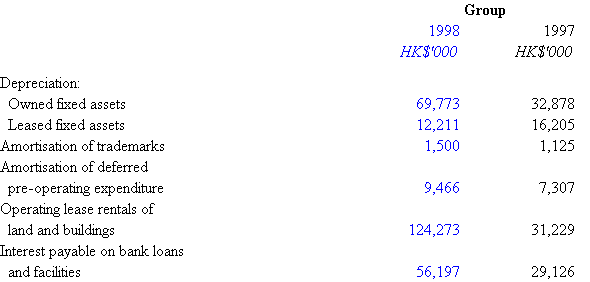
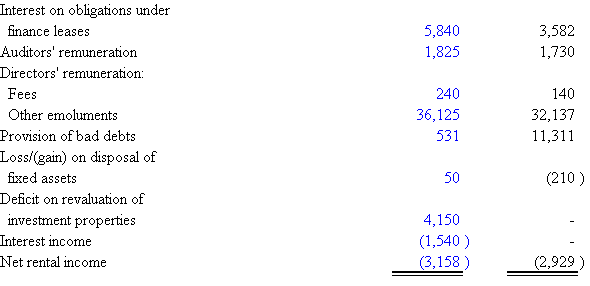
During the financial year, options to acquire shares of the Company were granted to certain directors. In the absence of a readily available market value for such options, the directors are unable to arrive at an accurate assessment of the value of these options.
Hong Kong profits tax has been provided at the rate of 16.5% (1997: 16.5%) on the estimated assessable profits arising in Hong Kong during the year. Taxes on profits in respect of subsidiaries operating overseas have been calculated at the rates of taxation prevailing in the respective tax jurisdiction in which they operate based on existing legislation, interpretations and practices in respect thereof.
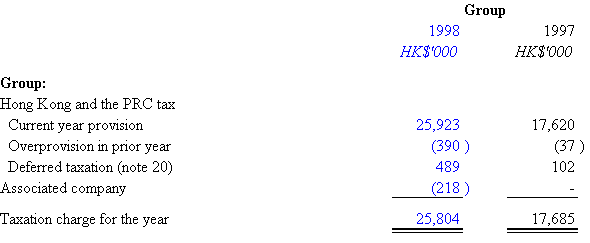
The net profit attributable to shareholders dealt with in the financial statements of the Company was HK$131,740,000 (1997: HK$93,186,000).
The Group's share of profit retained by the associated company for the year amounted to HK$7,041,000.

The dividends per share for the prior year has been adjusted to reflect the subdivision of shares of HK$0.10 each into two shares of HK$0.05 each during the year. (see note 21)
The calculation of earnings per share is based on the net profit attributable to shareholders for the year of HK$249,005,000 (1997: HK$245,793,000) on the weighted average of 1,285,063,178 shares (1997: 1,206,316,712 shares) in issue during the year. The fully diluted earnings per share for the current year is not shown as the exercise of all outstanding share options would not have material dilution effect on earnings per share.
The earnings per share for prior year have been adjusted to reflect the subdivision of shares of HK$0.10 each into two shares of HK$0.05 each during the year (see note 21).
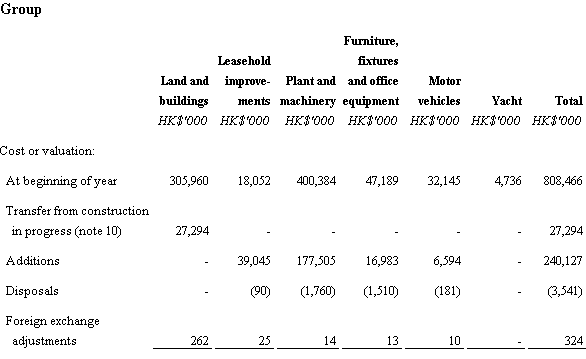
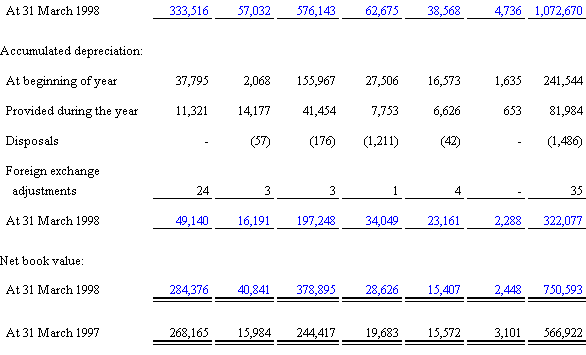
The analysis of the leasehold land and buildings at 31 March 1998 is as follows:
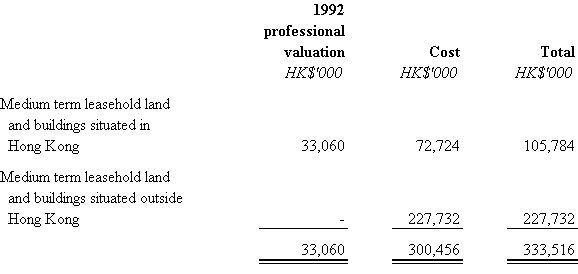
All the other fixed assets are stated at cost less accumulated depreciation.
The medium term leasehold land and buildings were revalued in 1992. The Group has adopted the transitional provisions of Statement of Standard Accounting Practice No. 17 "Property, plant and equipment" of not making regular revaluations by class of those assets stated at revalued amounts based on revaluations which were reflected in the prior year financial statements. Had such land and buildings been carried at cost less accumulated depreciation, their carrying values would have been stated at approximately HK$19,360,000 (1997: HK$20,119,000).
The properties situated in Hong Kong are pledged to the Group's bankers to secure the Group's bank borrowings.
Included in the total amount of fixed assets at 31 March 1998, the net book value of assets held under finance leases amounted to HK$86,339,000 (1997: HK$96,660,000).
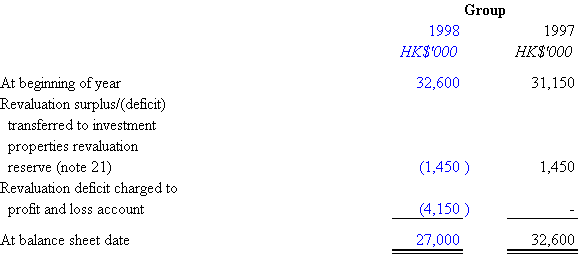
The investment properties are all situated in Hong Kong and are held under medium term leases. At 31 March 1998, the investment properties were revalued on an open market existing use basis by A.G. Wilkinson & Associates, Chartered Surveyors.
The gross rental income earned from investment properties during the year amounted to HK$3,025,000 (1997: HK$2,975,000).
The investment properties are pledged to the Group's bankers to secure the Group's bank borrowings.
| © Copyright 1996-2025 irasia.com Ltd. All rights reserved. |
|
DISCLAIMER: irasia.com Ltd makes no guarantee as to the accuracy or completeness of any
information provided on this website. Under no circumstances shall irasia.com Ltd be liable
for damages resulting from the use of the information provided on this website.
TRADEMARK & COPYRIGHT: All intellectual property rights subsisting in the contents of this website belong to irasia.com Ltd or have been lawfully licensed to irasia.com Ltd for use on this website. All rights under applicable laws are hereby reserved. Reproduction of this website in whole or in part without the express written permission of irasia.com Ltd is strictly prohibited. TERMS OF USE: Please read the Terms of Use governing the use of our website. |